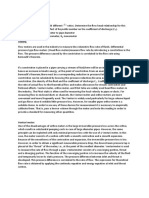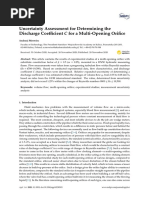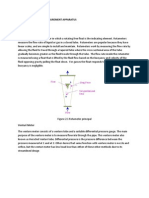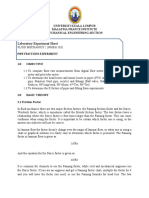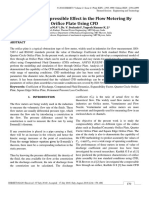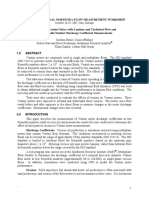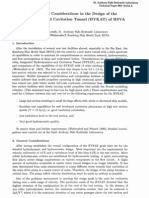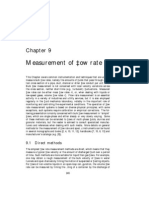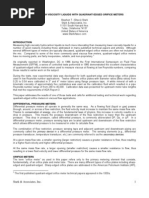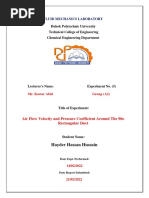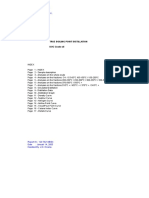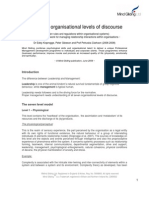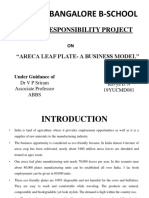Venturi CD at Laminar Flow
Venturi CD at Laminar Flow
Uploaded by
Fatih FıratCopyright:
Available Formats
Venturi CD at Laminar Flow
Venturi CD at Laminar Flow
Uploaded by
Fatih FıratOriginal Description:
Copyright
Available Formats
Share this document
Did you find this document useful?
Is this content inappropriate?
Copyright:
Available Formats
Venturi CD at Laminar Flow
Venturi CD at Laminar Flow
Uploaded by
Fatih FıratCopyright:
Available Formats
International Journal of Engineering and Technical Research (IJETR)
ISSN: 2321-0869, Volume-3, Issue-5, May 2015
Predictionof discharge coefficient of Venturimeter at
low Reynolds numbers by analytical and CFD
Method
Arun R, Yogesh Kumar K J, V Seshadri
Abstract- The venturimeter is a typical obstruction type flow
meter, widely used in industries for flow measurements. The
ISO standard (ISO-5167-1) provides the value of discharge
coefficients for the classical venturimeters in turbulent flows
with Reynolds number above 2x105. But in case of viscous fluids,
venturimeters are sometimes operated in laminar flow rather
than turbulent flow at Reynolds number below the range
covered by the standards. In the present work, an attempt was
made to study, prepare a computational model of a venturimeter,
which can be used as an efficient and easy means for predicting
the discharge coefficients at low Reynolds number. The
computational fluid dynamics (CFD) software ANSYS
FLUENT-14 has been used as a tool to perform the modeling
and simulation of venturimeter. Simulation was carried out for a
standard venturimeter and the results were validated with the
standards. Further the focus of the study was directed towards
flows with low Reynolds numbers commonly associated with
pipe line transportation of viscous fluids. An analytical
correlation for discharge coefficient in the laminar region was
derived by considering the viscous losses that occur between two
pressure taps. The results of the simulations show that the
discharge coefficient decreases rapidly as the Reynolds number
decreases. The results were compared with the analytically
proposed equation to calculate Cd at low Re and also with the
experimental data of Gordon Stobie [1]. The results obtained
from all three modes of calculations were with an uncertainty of
0.9 per cent.
Index Terms- Venturimeter, Computational Fluid Dynamics
(CFD), Coefficient of discharge (Cd), Low Reynolds number.
area available for flow at the constriction and the discharge
coefficient, the rate of discharge from the constriction can be
calculated. The discharge coefficient Cd is the ratio of actual
flow to the theoretical flow. The widely used flow meters in
the industries are orifice meter, venturimeter and Pitot tube.
Venturimeter and orifice meter are more convenient and
frequently used for measuring flow in an enclosed ducts or
channels.
Venturi meters are commonly used in single and
multiphase flows. The conditions encountered in metering
viscous fluids can be beyond the range of applicability of the
industry standards (ISO 5167-1). The ISO standard is limited
to turbulent flows for Reynolds numbers (based on the
upstream pipe diameter) above 2x105. Metering viscous oils
may involve laminar, rather than turbulent flow at Reynolds
numbers below the range covered by the ISO standard. Little
data are available on Venturi discharge coefficients in laminar
flow. Hence CFD modeling was conducted to simulate flow
through venturimeter at very low Reynolds number. The
objectives was to gain additional insight into low Reynolds
number flows in Venturi meters to evaluate how well CFD
modeling and analytical calculation can predict the
experimental results.
A. Principle of Venturimeter:
The venturimeter is an obstruction type flow meter
named in honor of Giovanni Venturi (1746-11822), an Italian
physicist who first tested conical expansion and contraction.
I. INTRODUCTION
The flow meters are being widely used in the industries to
measure the volumetric flow rate of the fluids. These flow
meters are usually differential pressure type, which measures
the flow rate by introducing a constriction in the flow. The
pressure difference caused by the constriction is used to
calculate the flow rate by using Bernoullis theorem.
If any constriction is placed in a pipe carrying a fluid, there
will be an increase in the velocity and hence the kinetic energy
increases at the point of constriction. From the energy balance
equation given by Bernoullis theorem, there must be a
corresponding reduction in the static pressure. Thus by
knowing the pressure reduction, the density of the fluid, the
Fig.1: Venturimeter
Arun R, M.Tech Student, Thermal Power Engineering, MIT-Mysore.
Yogesh Kumar K J, Assistant Professor, Department of Mechanical
Engineering, MIT-Mysore.
V Seshadri, Professor, Departmental of Applied Mechanics, IIT-Delhi,
New Delhi.
168
The classical venturimeter consists of a converging section,
throat and a diverging section as shown in the figure 1. The
function of the converging section is to increase the velocity
of the fluid and temporarily reduce its static pressure. Thus
www.erpublication.org
Predictionof discharge coefficient of Venturimeter at low Reynolds numbers by analytical and CFD Method
the pressure difference between the inlet and the throat is
developed. This pressure difference is correlated to the rate of
flow of fluid by using Bernoullis equation. As the theorem
states that In a steady, ideal flow of an incompressible fluid,
the total energy at any point of fluid is constant, the total
energy consists of pressure energy, kinetic energy and
potential energy.
drops for various values of angle of divergence and inlet
velocities for the different venturi profiles.
In this present work, CFD modeling was conducted to
simulate flow through venturimeter at very low Reynolds
number and the objectives was to gain an additional insight
into low Reynolds number flows in Venturi meters by using
CFD and to propose an analytical correlation to predict the
value of Cd at low Reynolds that match up with the
experimental data.
II. CFD MODELING AND SIMULATION
Because of the smoothness of the contraction and
expansion section of venturi, the irreversible pressure loss is
low. However, in order to obtain a significant measurable
pressure drop, the downstream pressure tap is located at the
throat of the venturimeter. In comparison of venturimeter with
the orifice meter, the pressure recovery is much better for
venturimeter than for the orifice plate, but there is no
complete pressure recovery. Pressure recovery is measured as
the pressure difference between inlet and outlet.
As per ISO 5167-1 [3], the mass flow rate in a Venturimeter
(Qm) is given by:
CFD modeling is a useful tool to gain an additional insight
into the physics of the flow and to understand the test results.
The objective of the CFD work was to model the flow using
2D CFD to obtain information about the flow that could not
be obtained in the experimental test program.
Model Description: The ANSYS FLUENT-14 CFD model
was used to model and simulate the laminar flow through a
venturimeter. The venturimeter geometry was modeled as a
2D-axisymmetric domain using a structured grid. The
dimensions of the geometry were taken from the ISO-5167-1
and no pressure taps were included in the CFD geometry.
The simulation was carried out for a standard classical
venturimeter with following dimensions and the model is
shown in the Fig.2
Where:
Cd = Venturimeter discharge coefficient
= Venturimeter beta ratio, d/D
= Expansion factor ( = 1, for incompressible flow)
d = Venturimeter throat diameter
D = Upstream pipe dia. of Venturi convergent section
P1 = Static pressure at the upstream pressure tap
P2 = Static pressure at the Venturi throat tap
= Fluid density at the upstream tap location
Equation (1) is based on the assumptions that the flow
steady, incompressible, and inviscid flow (no frictional
pressure losses) and uniform velocity profiles occur at the
pressure tap locations. However in order to take into account
the real fluid effects like viscosity and compressibility to
empirical coefficients Cd and are introduced in the equation.
In this paper we are considering only incompressible flow
therefore = 1.
Over the years the venturimeters have been used for metering
the different flows (liquid, gas, mixed flow). The
performances of these meters in terms of value of discharge
coefficient and pressure loss have been investigated by
several researchers. Gordon Stobie et al [1] made a
performance study on effect oferosion in a Venturi Meter with
Laminar and Turbulent Flow and measurement of discharge
coefficient at low Reynolds Number.Naveenji Arun et al [6]
conducted a CFD analysis to predict the discharge co-efficient
of venturimeter as a function of Reynolds number with
different beta ratios for single phase non-Newtonian flows. C.
L. Hollingshead et al [2], conducted experimental studies on
discharge coefficients of venturi and validated using
numerical analysis. T. Nithin et al [4] investigated the effect
of divergence angle on the total and differential pressure
Fig.2. Classical Venturimeter
Variables
Values
Units
Diameter of pipe
100
mm
Diameter of throat
50
mm
-ratio
0.5
--Upstream pipe length
6D
mm
Downstream pipe length
20D
mm
Convergent angle
21
deg
Divergent angle
9
deg
Table 1: Dimensions of Venturi geometry
Fig. 3 shows the CFD grid used for the venturimeter
simulation. The modeled geometry includes 6D of straight
pipe upstream of the convergent section and a 20D of straight
pipe downstream of divergent section. The convergent, throat
and divergent region were meshed with very fine grids, while
the upstream and downstream pipe region was meshed with
coarse grids. A total of 183546 quadrilateral elements were
used to generate a suitable mesh for the analysis.
169
www.erpublication.org
International Journal of Engineering and Technical Research (IJETR)
ISSN: 2321-0869, Volume-3, Issue-5, May 2015
In the modeling, mass, momentum, energy conservation
equations (if necessary) must be satisfied. The governing
equations for steady incompressible flows are:
Conservation of mass equation, this equation is valid for
both incompressible and compressible flows.
Conservation of momentum equation and for steady flow it
is written as,
Fig.3. Computational grids used for venturimeter simulation
III. CONVERGENCE AND VALIDATION OF CFD
METHODOLOGY:
As per the ISO-5167-1 [3], the different types of classical
venturimeter based on methods of manufacturing are,
classical venturi tube with an as cast convergent section,
classical venturi tube with a machined convergent section and
classical venturi tube with a rough-weld sheet-iron
convergent section.
For validation of CFD methodology a standard classical
venturimeter with a machined convergent section was
selected. As per ISO-5167-1, the standard dimensions of a
classical venturimeter with a machined convergent section are
in the ranges of,
50mm < D <250mm
0.4 < < 0.75
2x105< Re < 1x106
The ISO-5167-1[3] also gives specification for various
geometry details like convergent and divergent angles, length
of the throat, sharpness of the edges etc. when the
venturimeter is fabricated as per the above requirements and
used in the limits of applicability the value of Cd for such a
meter would be 0.995 with an uncertainty limit of 1.25%.
Based on the standard limits, a venturimeter with
D=100mm and =0.5 was constructed as a 2D axis symmetric
geometry. In the simulation procedure, the process of grid
generation is a very crucial step for better accuracy, stability
and economy of prediction. Based on mesh convergence
study, it is revealed that a total of quadrilateral elements
beyond 150000 yields a consistent result. Hence a total of
183546 quadrilateral elements were used.
170
Where p is the static pressure, g is the gravitational
body force.
It is an unfortunate fact that no single turbulence model is
universally accepted as being superior for all classes of
problems. The choice of turbulence model will depend on
considerations such as the physics encompassed in the flow,
the established practice for a specific class of problem, the
level of accuracy required, the available computational
resources, and the amount of time available for the simulation.
Among various turbulence models available, the realizable
k- model is a relatively recent development and differsfrom
the standard k- model in two important ways:
a) The realizable k- model contains a new formulation for
the turbulentviscosity.
b) A new transport equation for the dissipation rate, , has
been derivedfrom an exact equation for the transport of the
mean-squarevorticity fluctuation.
The term realizable" means that the model satisfies certain
mathematical constraints on the Reynolds stresses, consistent
with the physics of turbulent flows. Neither the standard k-
model nor the RNG k- model is realizable.
An immediate benefit of the realizable k- model is that it
more accurately predicts the spreading rate of both planar and
round jets. It is also likely to provide superior performance for
flows involving rotation, boundary layers under strong
adverse pressure gradients, separation, and recirculation.
Thus the Realizable k- turbulence model with standard
wall conditions was selected to model the flow domain as it is
superior to the Standard k- model for the prediction of
separated turbulent flows. SIMPLE algorithm with second
order upwind differencing scheme was used for iterative
process.Velocity at the inlet was specified as 1m/s and at
outlet the gauge pressure was set to zero. The heat transfer
from the wall of the domain was neglected.The solution was
computed in the commercial CFD code Fluent 14, in which
the pressure based solver, was selected for this particular case.
The results obtained from the CFD simulations were very
close to the Cd value specified in the standard ISO 5167-1 and
hence CFD methodology was validated.
Reynolds
Cd specified in
Cd obtained from
Number
ISO 5167-1
CFD
5
5x10
0.995
0.989
Table 2.Comparison of Cd value of ISO 5167-1 and CFD Cd
value
www.erpublication.org
Predictionof discharge coefficient of Venturimeter at low Reynolds numbers by analytical and CFD Method
specified and the heat transfer from the wall of the domain
was neglected. The flow solutions were obtained for steady,
incompressible flow. The range of Reynolds number covered
in this computation is from 1 to 1500.
Analytical correlation for the discharge coefficient of
venturimeter in laminar region:
Pressure contour: Max=8.83x102, Min= -9.82x103
Fig.6. Venturimeter
Assuming the flow is ideal and applying Bernoullis
equation before and after contraction,
But Z1= Z2,
Velocity contour: Max=4.37, Min=0
Fig.4. Pressure and velocity contours of Venturimeter
From continuity equation, we have
The above equation is based on the assumptions that the
flow is steady, incompressible, inviscid, irrotational, no losses
and the velocities V1 and V2 are constant across the cross
section.
Velocity vectors: Max=4.41, Min=3.62
Fig.5. Velocity vectors
IV. PREDICTION OF CD AT LOW REYNOLDS NUMBER
In the prediction of Cd at low Re the venturimeter was
modeled as per the dimensions specified in the table 2.In
simulating a fully-developed laminar flow profile at the
Venturi meter inlet, a laminar velocity profile was prescribed
at the pipe inlet with throat Reynolds number, located six D
upstream of the upstream pressure tap. This ensured a
fully-developed laminar velocity profile at the Venturi
upstream pressure tap location.
The laminar model with standard wall conditions was
selected to model the flowin the laminar region for the
prediction of Cd. The solution was computed in the
commercial CFD code Fluent 14, in which the pressure based
solver, was selected for this particular case. The velocity at
the inlet was specified as 1m/s, the gauge pressure at the outlet
was set to zero Pascal. At the wall no slip condition was
The coefficient of discharge Cd takes care of real fluid
effects i.e., the kinetic energy correction factor, viscous
effects and the losses due to sharp edges.
As per ISO-5167-1 [3], for a classical venturimeter the
flow with Reynolds number RD> 2x105 the value of discharge
coefficient Cd is equal to 0.995, therefore the losses are only
0.5%. But in case of laminar flow the losses are higher and it
is mainly due to viscous losses. When a liquid is flowing
through a pipe, the velocity of the liquid layer adjacent to the
pipe wall is zero. The velocity of liquid goes on increasing
from the wall and thus velocity gradient and hence shear
stresses are produced in the whole liquid due to viscosity.
This viscous action causes loss of energy which is usually
known as frictional loss. Thus the fluid experiences some
resistance due to which some of the energy of fluid is lost, this
head loss is due to friction and is given by Darcys law,
171
www.erpublication.org
International Journal of Engineering and Technical Research (IJETR)
ISSN: 2321-0869, Volume-3, Issue-5, May 2015
the corner loses and kinetic energy correction factors.
However it should represent the trend in the variation of Cd
with Reynolds number in the laminar region.
Therefore,
V. RESULTS AND DISCUSSIONS
Where, f is the friction factor which is a function of
Reynolds number and for laminar flow f is given by,
Now, applying Bernoullis equation between two pressure
taps,
To estimate the value of L/D between the section (1) and
(2), we will use local D.
In the pipe, L/D = 0.5
In the throat, L/D = 0.5
In
converging
portion,
for
=0.5
CFD simulations were performed over a wide range of
conditions. Venturimeter discharge coefficients were
calculated from the CFD predicted venturi pressure drops and
the flow rates. The simulations were done for different low
Reynolds numbers by varying the fluid viscosities and
keeping the constant inlet velocity as 1m/s. Initially the
simulation was carried out for a standard classical machined
venturimeter and the CFD results were validated with the
standard.
The simulations for actual low Reynolds number were
carried out and the CFD results were validated with the
experimental test data available [1]. Additional CFD
simulations were conducted to predict Venturi meter
operation at Reynolds numbers lower than that could be tested
in the laboratory.
The CFD results were also compared with the analytically
calculated Cd by using the correlation.
But,
Where, for laminar flow f is given by
Therefore,
Thus the total actual (L/D) between the sections (1) and (2)
= (0.5+1.8+0.5) = 2.8
For simplicity, we will put V=V2 in Darcy equation and
f=64/Red.
Therefore
for
laminar
flow
we
get,
The CFD discharge coefficients follow the same general
trends as the experimental and analytical results, but CFD
results do not agree exactly with any of the correlations. For
Reynolds numbers below about 1,000, the data falls within the
range of the various published results. Table 3, shows the
comparison of CFD results with experimental data available
and the analytical result.
In figure 7, the discharge coefficients for the venturimeter
from CFD simulations are compared with published data from
several sources and also with the analytically predicted
discharge coefficients. The discharge coefficients were found
to follow the same general trends as the published results. And
also the overall behavior of the discharge coefficient curve is
found to be consistent with what is described in the literature
and ISO 5167-1.
Sl.No.
Red
Expt.
CdValue
(Stobie
et. al [1])
0.101
0.072
10
0.295
0.223
35
0.460
0.393
80
0.573
0.542
100
0.590
0.602
0.585
200
0.700
0.687
0.714
500
0.820
0.778
0.850
1000
0.880
0.855
0.916
Comparing (A) and (B) we get,
If =0.5 then,
Where f=64/Red
Equation (c) gives the discharge coefficient for the laminar
flow with Reynolds number less than 2000 and beta ratio
equal to 0.5. The above equation does not take into account
172
CFD
Simulated
Cd results
Analytically
Calculated
Cd Value
1500
0.890
0.875
0.937
Table 3. Comparison of Discharge coefficients
www.erpublication.org
Predictionof discharge coefficient of Venturimeter at low Reynolds numbers by analytical and CFD Method
[3] Indian standard ISO-5167-1, Measurement of fluid flow by means of
pressure differential devices (1991).
[4] T. Nithin, Nikhil Jain and AdarshaHiriyannaiah (2012). Optimization of
Venturi Flow Meter Model for the Angle of Divergence with Minimal
Pressure Drop by Computational Fluid Dynamics Method.
International Conference on Challenges and Opportunities in
Mechanical Engineering, Industrial Engineering and Management
Studies.
[5] Nikhil
Tamhankar,
Amar
Pandhare,
AshwinkumarJoglekar,
VaibhavBansode (2014). Experimental and CFD analysis of flow
through venturimeter to determine the coefficient of discharge.
International Journal of Latest Trends in Engineering and Technology.
[6] Naveenji Arun, Malavarayan S, Kaushik M, H.Sriananth (2010). CFD
analysis on discharge coefficient during non Newtonian flows through
orifice meter. International Journal of Engineering Science and
Technology Vol. 2(7).
[7] P. Hari Vijay, V. Subrahmanyam(2014). CFD simulation on different
geometries of venturimeter. International Journal of Latest Trends in
Engineering and Technology vol-3
Fig.7: Comparison of published values of venturimeter
discharge coefficients for low Re with the CFD results
The agreement between the analytically calculated and
CFD simulated results is good; although it appears that two
data sets have slightly different slopes. Also the CFD results
were in close comparison with the experimental data [1]. The
favorable agreement between the analytical, CFD and
experimental results suggests that CFD can be used to model
the low Reynolds number flows when using venturimeters.
VI. CONCLUSIONS
CFD modeling and simulation was performed to determine
if CFD simulations could predict the performance of a
venturimeter under non-ISO standard conditions typically
encountered in metering viscous fluids. The results obtained
from CFD were used to study the detailed information on
venturimeter flow characteristics that could not be easily
measured during experimental testing at very low Reynolds
number.
Considering the uncertainty involved in the experimental
study and CFD analysis, the agreement between the computed
values and experimental data of Cd can be considered as
satisfactory.It can also be inferred that for a laminar flow in a
specific venturimeter (fixed D and ), the discharge
coefficient is a function of throat Reynolds number over a
range of viscosities and flow rates.
It is observed that as the Reynolds number decreases, the
value of Cd reduces very rapidly. This can be attributed to the
viscous losses that occur at these Reynolds number. Hence
while using venturimeter at low Reynolds number, it is
essential to use the correct value of Cd.
It is also necessary to be mentioned that since Cd varies
significantly with Re (hence flow rate), it is not very
convenient to use venturimeter for such applications because
Cdwill not be known a prior. Hence it would require an
iteration process to arrive at the actual flow rate.
REFERENCES
[1] Gordon Stobie, Conoco Phillips, Robert Hart and Steve Svedeman,
Southwest Research Institute. Erosion in a Venturi Meter with Laminar
and Turbulent Flow and Low Reynolds Number Discharge Coefficient
Measurements.
[2] C.L. Hollingshead, M.C. Johnson, S.L. Barfuss, R.E. Spall (2011).
Discharge coefficient performance of Venturi, standard concentric
orifice plate, V-cone and wedge flow meters at low Reynolds numbers.
Journal of Petroleum Science and Engineering.
173
www.erpublication.org
You might also like
- Air Flow RigDocument27 pagesAir Flow RigOsan Thorpe100% (5)
- Ethanol Amine Production PDFDocument8 pagesEthanol Amine Production PDFFatih FıratNo ratings yet
- KULI Overview 20110720 BRGDocument37 pagesKULI Overview 20110720 BRGMurat KavasNo ratings yet
- IJETR032191Document6 pagesIJETR032191erpublicationNo ratings yet
- Venturimeter ExptDocument9 pagesVenturimeter Exptatif irshadNo ratings yet
- Characteristics of Flow Meters With Sediment Laden PDFDocument4 pagesCharacteristics of Flow Meters With Sediment Laden PDFDigvijay SinghNo ratings yet
- Theory VenturiDocument7 pagesTheory VenturiMahendranath RamakrishnanNo ratings yet
- UntitledDocument6 pagesUntitledJonah OrjiNo ratings yet
- Applied Sciences: Uncertainty Assessment For Determining The Discharge CoeDocument10 pagesApplied Sciences: Uncertainty Assessment For Determining The Discharge CoeSakil MollahNo ratings yet
- Lab Session 03 UptadeDocument7 pagesLab Session 03 UptadeAbdullah SahirNo ratings yet
- Lab Manual 2012 Fluid MechanicsDocument23 pagesLab Manual 2012 Fluid MechanicsUsman HaiderNo ratings yet
- Al-Farabi University CollegeDocument15 pagesAl-Farabi University CollegeHamzah A. LaftaNo ratings yet
- Orifice, Nozzle and Venturi Flow Rate Meters: Water & Air FlowmetersDocument4 pagesOrifice, Nozzle and Venturi Flow Rate Meters: Water & Air Flowmeterssiva_nagesh_2No ratings yet
- Fluid Flow Lab: Experiment 4Document13 pagesFluid Flow Lab: Experiment 4shubhamNo ratings yet
- Metrology and Measurement Systems: Index 330930, ISSN 0860-8229 WWW - Metrology.pg - Gda.plDocument14 pagesMetrology and Measurement Systems: Index 330930, ISSN 0860-8229 WWW - Metrology.pg - Gda.pleduryuNo ratings yet
- The Bernoulli EquationDocument7 pagesThe Bernoulli EquationRajesh N Priya GopinathanNo ratings yet
- Topic 2: Flowmeter Measurement Apparatus 2.1 THEORY: RotameterDocument6 pagesTopic 2: Flowmeter Measurement Apparatus 2.1 THEORY: Rotameterpelinces_cityNo ratings yet
- Fluid Friction Measurement Experiment Jan20Document5 pagesFluid Friction Measurement Experiment Jan20Ammar AzfarNo ratings yet
- Manual-Flow MeterDocument9 pagesManual-Flow MeterOmar AhmedNo ratings yet
- Q D 4 2 P 1 D D: Ideal 2 4Document2 pagesQ D 4 2 P 1 D D: Ideal 2 4MuhammadAzrulNo ratings yet
- Numerical Analysis of The Performance Characteristics of Conical Entrance Orifice MeterDocument9 pagesNumerical Analysis of The Performance Characteristics of Conical Entrance Orifice MeterFILIPRNo ratings yet
- Analysis of Performance of V-Cone Meter - Experimental & CFDDocument7 pagesAnalysis of Performance of V-Cone Meter - Experimental & CFDpratheesh91No ratings yet
- Butterfly Valve and FlowDocument5 pagesButterfly Valve and FlowMurugan RangarajanNo ratings yet
- Experimental and Numerical Analysis of Different Aerodynamic Properties of Circular CylinderDocument6 pagesExperimental and Numerical Analysis of Different Aerodynamic Properties of Circular Cylinderpramo_dassNo ratings yet
- Analysis of Compressible Effect in The Flow Metering by Orifice Plate Using CFDDocument11 pagesAnalysis of Compressible Effect in The Flow Metering by Orifice Plate Using CFDSid SharmaNo ratings yet
- Analysis of Venture Meter Using Computational Fluid Dynamics CFD For Performance Improvement Ijariie8284 PDFDocument9 pagesAnalysis of Venture Meter Using Computational Fluid Dynamics CFD For Performance Improvement Ijariie8284 PDFThaboNo ratings yet
- Fluid LABDocument9 pagesFluid LABKayfe sayfadeenNo ratings yet
- 2007 15 Erosion in A Venturi Meter With Laminar and Turbulent Flow and Low Reynolds Number Stobie ConocoPhillips PDFDocument21 pages2007 15 Erosion in A Venturi Meter With Laminar and Turbulent Flow and Low Reynolds Number Stobie ConocoPhillips PDFThaboNo ratings yet
- 15 - Investigation of Turbulent Airflow in A Circular Pipe Using Different Orifice Plate Geometries - Ballil and Jolgam-2022Document6 pages15 - Investigation of Turbulent Airflow in A Circular Pipe Using Different Orifice Plate Geometries - Ballil and Jolgam-2022bnahmedali68No ratings yet
- Design of The HVA Water TunnelDocument10 pagesDesign of The HVA Water TunnelSjoerd_BNo ratings yet
- RotametreDocument9 pagesRotametreJohn AdewaleNo ratings yet
- Venturi Orifice Meter: Flow Measuring DevicesDocument22 pagesVenturi Orifice Meter: Flow Measuring DevicesAryan ChaurasiaNo ratings yet
- Prediction of Flow Coefficient and Hydrodynamic Torque Coefficient in Butterfly ValveDocument5 pagesPrediction of Flow Coefficient and Hydrodynamic Torque Coefficient in Butterfly ValveRajeshNo ratings yet
- Effect of Ejector Con Guration On Hydrodynamic Characteristics of Gas-Liquid Ejectors PDFDocument11 pagesEffect of Ejector Con Guration On Hydrodynamic Characteristics of Gas-Liquid Ejectors PDFPan MachinneNo ratings yet
- Flow MetersDocument16 pagesFlow MetersSyarif HidayatNo ratings yet
- Differential Head Flowmeters (Usbr - Gov) (ISO-5167 Stolz Equation) .HTMLDocument7 pagesDifferential Head Flowmeters (Usbr - Gov) (ISO-5167 Stolz Equation) .HTMLempanadaNo ratings yet
- FFFFF TheoryDocument9 pagesFFFFF TheoryifiokNo ratings yet
- Measurment of Fluid FlowDocument6 pagesMeasurment of Fluid FlowRajivparaj 李瑞杰No ratings yet
- Orifice PlateDocument14 pagesOrifice PlateAyoun Ul HaqueNo ratings yet
- Esra Dhyaa Fluid Report Second StageDocument7 pagesEsra Dhyaa Fluid Report Second StageMostafa HamawandyNo ratings yet
- Mathematical Modeling of Fluid Flow Through Multiple Orifice and Its Use For Fluid Flow MeasurementDocument9 pagesMathematical Modeling of Fluid Flow Through Multiple Orifice and Its Use For Fluid Flow MeasurementRodrigo LimaNo ratings yet
- Sesion 5 FLOW MEASUREMENTDocument32 pagesSesion 5 FLOW MEASUREMENTmuh amarNo ratings yet
- Pipe Flow HydraulicsDocument8 pagesPipe Flow HydraulicsNeel DodhiaNo ratings yet
- Lab Report 4Document7 pagesLab Report 4api-300265822100% (1)
- Flow MeasurementDocument10 pagesFlow Measurementiroshauk67% (3)
- Flow MeasurementDocument11 pagesFlow MeasurementRaj Ven100% (1)
- Bsen 3310 Flow Meter Discharge Coefficient EstimationDocument7 pagesBsen 3310 Flow Meter Discharge Coefficient Estimationapi-300980681No ratings yet
- Air Flow and Charge Motion Study of Engine Intake PortDocument9 pagesAir Flow and Charge Motion Study of Engine Intake PortAshokNo ratings yet
- CFD FinalDocument17 pagesCFD FinalSameer NasirNo ratings yet
- Measuring High Viscosity Liquids With Quadrant-Edged Orifice MetersDocument5 pagesMeasuring High Viscosity Liquids With Quadrant-Edged Orifice Metersaugur886No ratings yet
- Designand Modelingof Ball Valve Final VersionDocument27 pagesDesignand Modelingof Ball Valve Final VersionBreno PenaNo ratings yet
- ET2070 Resit Question 1 (Fluid Mechanics)Document11 pagesET2070 Resit Question 1 (Fluid Mechanics)Alan ClarkNo ratings yet
- Mass Flow Rate Measurement of Gas/Liquid Two-Phase Flow in Horizontal Pipe Based On V-Cone Flow Meter and Adaptive Wavelet NetworkDocument6 pagesMass Flow Rate Measurement of Gas/Liquid Two-Phase Flow in Horizontal Pipe Based On V-Cone Flow Meter and Adaptive Wavelet NetworkFernando GuerreroNo ratings yet
- A Brief Study of The Most Commonly Used Flow MetersDocument21 pagesA Brief Study of The Most Commonly Used Flow MeterssumeghNo ratings yet
- Calibration of Venturimeter and OrificmeterDocument2 pagesCalibration of Venturimeter and OrificmeterHimanshu SinghNo ratings yet
- Flowmeter Types and Their PrinciplesDocument4 pagesFlowmeter Types and Their Principlesadib assoliNo ratings yet
- 1 s2.0 S187638041260072X MainDocument6 pages1 s2.0 S187638041260072X MainHareesh MaranNo ratings yet
- Air Flow Velocity and Pressure Coefficient Around The 90o Rectangular Duct (Fluid Exp 5)Document9 pagesAir Flow Velocity and Pressure Coefficient Around The 90o Rectangular Duct (Fluid Exp 5)hayder alaliNo ratings yet
- Theoretical Uncertainty of Orifice Flow Measurement TechWpaperDocument8 pagesTheoretical Uncertainty of Orifice Flow Measurement TechWpaperFikri AchdanNo ratings yet
- API 620 Appendix R Tanks For Storage of Refrigerated Product PDFDocument16 pagesAPI 620 Appendix R Tanks For Storage of Refrigerated Product PDFFatih FıratNo ratings yet
- Ethanol Amine ProductionDocument8 pagesEthanol Amine ProductionFatih FıratNo ratings yet
- Maersk Olie Og Gas AS Esplanaden 50 DK-1263 Copenhagen K. Denmark Attn. Mr. L. AnderssonDocument21 pagesMaersk Olie Og Gas AS Esplanaden 50 DK-1263 Copenhagen K. Denmark Attn. Mr. L. AnderssonFatih FıratNo ratings yet
- Improved Control Valve Sizing For Multiphase FlowDocument5 pagesImproved Control Valve Sizing For Multiphase FlowFatih FıratNo ratings yet
- Ejector Data SheetDocument5 pagesEjector Data SheetFatih FıratNo ratings yet
- Heat Exchanger Input Correction FactorDocument11 pagesHeat Exchanger Input Correction FactorFatih FıratNo ratings yet
- Catalyst To EthanolDocument26 pagesCatalyst To EthanolFatih FıratNo ratings yet
- Dynamic Modeling and Simulation of Low Density Polyethylene Production - A Comparative StudyDocument6 pagesDynamic Modeling and Simulation of Low Density Polyethylene Production - A Comparative StudyFatih FıratNo ratings yet
- DWC Column SimulationDocument14 pagesDWC Column SimulationFatih FıratNo ratings yet
- Creative Electronics Group BDocument44 pagesCreative Electronics Group BumairNo ratings yet
- Rules of Chart Interpretation and Evaluation of Polygraph ResultsDocument8 pagesRules of Chart Interpretation and Evaluation of Polygraph ResultsNick clarence SolimanNo ratings yet
- Bison & Walrus Error CodesDocument5 pagesBison & Walrus Error Codesalsomate.mNo ratings yet
- Science 4 Quarter 2 MELC - Based Summative Test #1Document12 pagesScience 4 Quarter 2 MELC - Based Summative Test #1Marie Jaja Tan Roa100% (4)
- How To Marry A MillionaireDocument72 pagesHow To Marry A MillionaireArjun0% (1)
- Chapter 5 Stacks and QueuesDocument23 pagesChapter 5 Stacks and QueuesEmulatorNo ratings yet
- Sri Venkateswara College of Engineering Course Delivery Plan - Theory Page 1 of 6Document6 pagesSri Venkateswara College of Engineering Course Delivery Plan - Theory Page 1 of 6Ʀoʛeʀ Ɩeo ƖɩbɩŋNo ratings yet
- Hand Vac Aspirateur À Main Aspiradora de Mano: Owner'S ManualDocument16 pagesHand Vac Aspirateur À Main Aspiradora de Mano: Owner'S Manualmarlon HernandezNo ratings yet
- The Seven Organisational Levels of DiscourseDocument9 pagesThe Seven Organisational Levels of DiscourseEddy Kloprogge100% (1)
- Shyira Diocese Test by JanviusDocument11 pagesShyira Diocese Test by Janviusari AristideNo ratings yet
- Poly (Meth) Acrylate Based CoatingsDocument9 pagesPoly (Meth) Acrylate Based CoatingssuryaprakashreddycNo ratings yet
- Vizualizing Earth History: Geologic TimeDocument36 pagesVizualizing Earth History: Geologic TimeNurlia AduNo ratings yet
- Bài Speaking C A VDocument27 pagesBài Speaking C A Vpmgpro3008No ratings yet
- Nanotechnology Research and Education in Turkey: Dr. Volkan ÖzgüzDocument24 pagesNanotechnology Research and Education in Turkey: Dr. Volkan ÖzgüzNaman MukundNo ratings yet
- Scribd 2Document80 pagesScribd 2Victor CantuárioNo ratings yet
- Ruminal Tympany (Bloat, Hoven) : Microbial Fermentation EructationDocument2 pagesRuminal Tympany (Bloat, Hoven) : Microbial Fermentation EructationKaran VetNo ratings yet
- Kavya SRPDocument10 pagesKavya SRPMadhuNo ratings yet
- A Coat of Varnish - What Is Duco Paint - How Is It Applied - PDFDocument4 pagesA Coat of Varnish - What Is Duco Paint - How Is It Applied - PDFJohn Rhey Lofranco TagalogNo ratings yet
- Texturized PETDocument2 pagesTexturized PETGauri PuranikNo ratings yet
- Protastructure Design Guide Column Design Verification by N M Interaction DiagramDocument20 pagesProtastructure Design Guide Column Design Verification by N M Interaction Diagramchong fung yunNo ratings yet
- Jannsen's Paper 1895Document7 pagesJannsen's Paper 1895Justin ZimmermanNo ratings yet
- Simulation and Optimization of 2 X 2 Mach-ZehnderDocument19 pagesSimulation and Optimization of 2 X 2 Mach-ZehnderKenjal JainNo ratings yet
- Rethinking SchoolDocument8 pagesRethinking Schoolriddhi patelNo ratings yet
- Project Report On Steel Industry of Tata Iron & Steel CoDocument10 pagesProject Report On Steel Industry of Tata Iron & Steel Cobhautikbschoolstudy100% (2)
- Aboriginal Prophecies 2012Document2 pagesAboriginal Prophecies 2012Vladimir ZarbenNo ratings yet
- NIT DurgapurDocument115 pagesNIT DurgapurSayak DasNo ratings yet
- Kernicterus. IfDocument2 pagesKernicterus. IfValledor Ian MosesNo ratings yet
- Servo Motor Position Control Using Ic 555 TimerDocument17 pagesServo Motor Position Control Using Ic 555 Timershiv100% (1)
- Natal Chart ReportDocument26 pagesNatal Chart Reportshanabessconde1975No ratings yet





